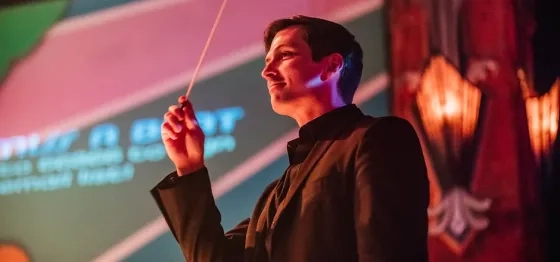NASCAR, the Blues and Queen Mary Meet in Wind Ensemble Concert
The evening includes a piece by composition faculty member Mason Bates, and a showcase for the winner of the inaugural Wind Ensemble Concerto Competition.
Where can you find music about NASCAR, the blues and Queen Mary, all in one program? Turns out, the answer is the SFCM Wind Ensemble's fall concert.
Taking place Nov. 10, the evening's program is a conscious attempt by the ensemble's director Brad Hogarth to put on a night of music where American and European musical traditions are intertwined.
Composition professor Mason Bates' work Bootlegger's Break opens proceedings. The piece, which received its world premiere in March at the University of Miami, is written about Lee Petty, a famous Prohibition-era getaway driver whose son Richard is one of NASCAR's most famous personalities.
"It's just a really exciting tune," Hogarth said. "It's a big, fun, chase-sequence piece with some quintessential Mason tonal language and techniques."
Michail Thompson, winner of the first-ever SFCM Wind Ensemble Concerto Competition, will be featured in the following performance, of Vassily Brandt's Concert Piece No. 1.
"The creation of the Conservatory's wind ensemble was in 2021, so we've only been around for a little while," Hogarth explained. "The idea of it was something focused on wind, brass, and percussion, where we can hone in on all the great repertoire there is for it, but also it's a place where they can dig into more instrument-specific playing and that will only enhance their playing in the orchestra. And the competition was an extension of that. We wanted to make sure there was an opportunity for students to be featured."
If a single composition encompasses the evening's Transatlantic theme, it's Steven Stucky's Funeral Music for Queen Mary, which in the composer's words "transcribes and elaborates" on Henry Purcell's themes for Mary's service.
"You definitely hear all of the elements of the original" in Stucky's work, Hogarth said, but he said the composer put Purcell's work "through a kaleidoscope."
"There are times when he's taking this main dirge funeral theme, which is the beautiful 15-bar form, and he's adding other things to it, so sometimes it's hidden under these other structures, or harmonies are stretched out in really interesting ways. And it's for orchestral winds, so there are no strings in it other than a harp."
Closing out the evening is William Grant Still's Afro-American Symphony, the first-ever symphony composed by an African-American man and performed by a major orchestra—in this case, the Rochester Philharmonic in 1931. Hogarth called it "one of the most important American symphonies," and it is believed to be the first use of the banjo in an orchestral setting.
"Still was really concerned with bringing the music of the Black community into the symphonic form," Hogarth said, "and he wanted to prove that it held up to what people were calling the music, the classical forms of the time and show what it had to offer."
Hogarth added that keen-eared listeners might spot a section in the third movement that sounds similar to George Gershwin's "I Got Rhythm," noting that there's an ongoing debate over whether or not the famous tune was partially lifted from Still's composition.
The last movement of the symphony is, depending on the edition, "Aspirations" or "Sincerity." Hogarth said, "There's an undertone in a lot of Still's music of working for and hoping for a better future for Black America, so a lot of his music feels that way: It embraces the struggle and celebrates progress, but it's always looking forward."
Guests are asked to reserve tickets for the Wind Ensemble's Nov. 10 concert. Learn more about studying woodwinds at SFCM here.
